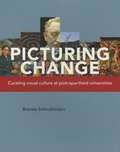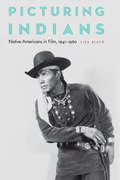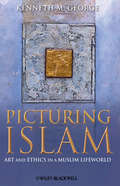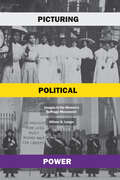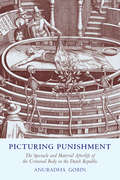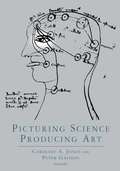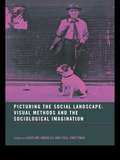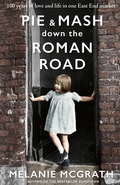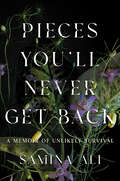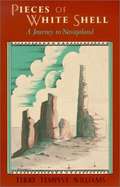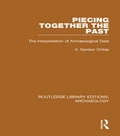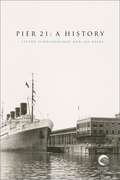- Table View
- List View
Pictures in the Air: The Story of the National Theatre of the Deaf
by Stephen C. BaldwinNow available in paperback; ISBN 1-56368-140-4
Picturing Casablanca: Portraits of Power in a Modern City
by Susan OssmanIn Picturing Casablanca, Susan Ossman probes the shape and texture of mass images in Casablanca, from posters, films, and videotapes to elections, staged political spectacles, and changing rituals. In a fluid style that blends ethnographic narrative, cultural reportage, and the author's firsthand experiences, Ossman sketches a radically new vision of Casablanca as a place where social practices, traditions, and structures of power are in flux.Ossman guides the reader through the labyrinthine byways of the city, where state bureaucracy and state power, the media and its portrayal of the outside world, and people's everyday lives are all on view. She demonstrates how images not only reflect but inform and alter daily experience. In the Arab League Park, teenagers use fashion and flirting to attract potential mates, defying traditional rules of conduct. Wedding ceremonies are transformed by the ubiquitous video camera, which becomes the event's most important spectator. Political leaders are molded by the state's adept manipulation of visual media.From Madonna videos and the TV's transformation of social time, to changing gender roles and new ways of producing and disseminating information, the Morocco that Ossman reveals is a telling commentary on the consequences of colonial planning, the influence of modern media, and the rituals of power and representation enacted by the state.
Picturing Change: Curating visual culture at post-apartheid universities
by Brenda SchmahmannAn in-depth look at the evolving ethos of curating and collecting art at South African universities. In Picturing Change, Brenda Schmahmann explores the implications of deploying the visual domain in the service of transformative agendas and unpacks the complexities, contradictions and slippages involved in this process. She shows that although most new commissions have been innovative, some universities have acquired works with potentially traditionalist - even backward-looking - implications. While the motives behind removing inherited imagery may be underpinned by a desire to unsettle white privilege, in some cases such actions can also serve to maintain the status quo. This book is unique in exploring the transformative ethos evident in the curation of visual culture at South African universities. It will be invaluable to readers interested in public art, the politics of curating and collecting, as well as to those involved in transforming tertiary and other public institutions into spaces that welcome diversity. Since South Africa's transition to democracy, many universities have acquired new works of art that convey messages about the advantages of cultural diversity, and engage critically with histories of racial intolerance and conflict. Given concerns about the influence of British imperialism or Afrikaner nationalism on aspects of their inherited visual culture, most tertiary institutions are also seeking new ways to manage their existing art collections, and to introduce memorials, insignia or regalia, which reflect the universities' newfound values and aspirations.
Picturing Dogs, Seeing Ourselves: Vintage American Photographs (Animalibus: Of Animals and Cultures #4)
by Ann-Janine MoreyDogs are as ubiquitous in American culture as white picket fences and apple pie, embracing all the meanings of wholesome domestic life—family, fidelity, comfort, protection, nurturance, and love—as well as symbolizing some of the less palatable connotations of home and family, including domination, subservience, and violence. In Picturing Dogs, Seeing Ourselves, Ann-Janine Morey presents a collection of antique photographs of dogs and their owners in order to investigate the meanings associated with the canine body. Included are reproductions of 115 postcards, cabinet cards, and cartes de visite that feature dogs in family and childhood snapshots, images of hunting, posed studio portraits, and many other settings between 1860 and 1950. These photographs offer poignant testimony to the American romance with dogs and show how the dog has become part of cultural expressions of race, class, and gender.Animal studies scholars have long argued that our representation of animals in print and in the visual arts has a profound connection to our lived cultural identity. Other books have documented the depiction of dogs in art and photography, but few have reached beyond the subject’s obvious appeal. Picturing Dogs, Seeing Ourselves draws on animal, visual, and literary studies to present an original and richly contextualized visual history of the relationship between Americans and their dogs. Though the personal stories behind these everyday photographs may be lost to us, their cultural significance is not.
Picturing Indians: Native Americans in Film, 1941-1960
by Liza BlackStanding at the intersection of Native history, labor, and representation, Picturing Indians presents a vivid portrait of the complicated experiences of Native actors on the sets of midcentury Hollywood Westerns. This behind-the-scenes look at costuming, makeup, contract negotiations, and union disparities uncovers an all-too-familiar narrative of racism and further complicates filmmakers&’ choices to follow mainstream representations of &“Indianness.&” Liza Black offers a rare and overlooked perspective on American cinema history by giving voice to creators of movie Indians—the stylists, public relations workers, and the actors themselves. In exploring the inherent racism in sensationalizing Native culture for profit, Black also chronicles the little-known attempts of studios to generate cultural authenticity and historical accuracy in their films. She discusses the studios&’ need for actual Indians to participate in, legitimate, and populate such filmic narratives. But studios also told stories that made Indians sound less than Indian because of their skin color, clothing, and inability to do functions and tasks considered authentically Indian by non-Indians. In the ongoing territorial dispossession of Native America, Native people worked in film as an economic strategy toward survival. Consulting new primary sources, Black has crafted an interdisciplinary experience showcasing what it meant to &“play Indian&” in post–World War II Hollywood.
Picturing Islam: Art and Ethics in a Muslim Lifeworld
by Kenneth M. GeorgePicturing Islam: Art and Ethics in a Muslim Lifeworld explores issues of religion, nationalism, ethnicity, and globalization through the life and work of the prominent contemporary Indonesian artist Abdul Djalil Pirous. Presents a unique addition to the anthropology of art and religion Demonstrates the impact of Islam, ethnicity, nationalism, and globalization on the work and life of an internationally recognized postcolonial artist Weaves together visual and narrative materials to tell an engrossing story of a cosmopolitan Muslim artist Looks at contemporary Islamic art and the way it has been produced in the world's largest Muslim nation, Indonesia
Picturing Political Power: Images in the Women’s Suffrage Movement
by Allison K. LangeFor as long as women have battled for equitable political representation in America, those battles have been defined by images—whether illustrations, engravings, photographs, or colorful chromolithograph posters. Some of these pictures have been flattering, many have been condescending, and others downright incendiary. They have drawn upon prevailing cultural ideas of women’s perceived roles and abilities and often have been circulated with pointedly political objectives. Picturing Political Power offers perhaps the most comprehensive analysis yet of the connection between images, gender, and power. In this examination of the fights that led to the ratification of the Nineteenth Amendment in 1920, Allison K. Lange explores how suffragists pioneered one of the first extensive visual campaigns in modern American history. She shows how pictures, from early engravings and photographs to colorful posters, proved central to suffragists’ efforts to change expectations for women, fighting back against the accepted norms of their times. In seeking to transform notions of womanhood and win the right to vote, white suffragists emphasized the compatibility of voting and motherhood, while Sojourner Truth and other leading suffragists of color employed pictures to secure respect and authority. Picturing Political Power demonstrates the centrality of visual politics to American women’s campaigns throughout the nineteenth and early twentieth centuries, revealing the power of images to change history.
Picturing Punishment: The Spectacle and Material Afterlife of the Criminal Body in the Dutch Republic
by Anuradha GobinPicturing Punishment examines representations of criminal bodies as they moved in, through, and out of publicly accessible spaces in the city during punishment rituals in the seventeenth-century Dutch Republic. Once put to death, the criminal cadaver did not come to rest. Its movement through public spaces indicated the potent afterlife of the deviant body, especially its ability to transform civic life. Focusing on material culture associated with key sites of punishment, Anuradha Gobin argues that the circulation of visual media related to criminal punishments was a particularly effective means of generating discourse and formulating public opinion, especially regarding the efficacy of civic authority. Certain types of objects related to criminal punishments served a key role in asserting republican ideals and demonstrating the ability of officials to maintain order and control. Conversely, the circulation of other types of images, such as inexpensive paintings and prints, had the potential to subvert official messages. As Gobin shows, visual culture thus facilitated a space in which potentially dissenting positions could be formulated while also bringing together seemingly disparate groups of people in a quest for new knowledge. Combining a diverse array of sources including architecture, paintings, prints, anatomical illustrations, and preserved body parts, Picturing Punishment demonstrates how the criminal corpse was reactivated, reanimated, and in many ways reintegrated into society.
Picturing Resistance: Moments and Movements of Social Change from the 1950s to Today
by Ken Light Melanie LightA compelling photographic history of the important moments of progressive resistance--from the civil rights movement to the present--to inspire the change-makers and activists of today.A powerful commemoration of notable moments of protest, Picturing Resistance highlights the important American social justice movements of the last seven decades. Including both black-and-white and color photographs, this important record pairs iconic and unexpected images with insightful narrative captions that contextualize the meanings behind the moments. UC Berkeley Graduate School of Journalism professor Ken Light and author Melanie Light have carefully curated unconventional photographs of the most memorable moments in twentieth- and twenty-first-century protest history, offering a fresh perspective on these important occasions. In place of the iconic image of Martin Luther King, Jr. speaking at the March on Washington, Picturing Resistance conveys the feeling of pain and frustration of the time period by instead showing him moments after being arrested, restrained against a police station table. The moments captured in Picturing Resistance take the reader on a journey through decades of people-powered protest, featuring images from the front lines of the civil rights, women's, environmental, and disability rights movements, as well as contemporary movements like Black Lives Matter and March for Our Lives. Picturing Resistance will inspire revolutionary thinkers, activists, and dreamers of all stripes to celebrate the milestones of the past as we build a progressive future.
Picturing Science, Producing Art
by Peter Galison Caroline A. JonesFirst Published in 1998. Routledge is an imprint of Taylor & Francis, an informa company.
Picturing the Postcard: A New Media Crisis at the Turn of the Century
by Monica CureThe first full-length study of a once revolutionary visual and linguistic medium Literature has &“died&” many times—this book tells the story of its death by postcard. Picturing the Postcard looks to this unlikely source to shed light on our collective, modern-day obsession with new media. The postcard, almost unimaginably now, produced at the end of the nineteenth century the same anxieties and hopes that many people think are unique to twenty-first-century social media such as Facebook or Twitter. It promised a newly connected social world accessible to all and threatened the breakdown of authentic social relations and even of language. Arguing that &“new media&” is as much a discursive object as a material one, and that it is always in dialogue with the media that came before it, Monica Cure reconstructs the postcard&’s history through journals, legal documents, and sources from popular culture, analyzing the postcard&’s representation in fiction by well-known writers such as E. M. Forster and Edith Wharton and by more obscure writers like Anne Sedgwick and Herbert Flowerdew. Writers deployed uproar over the new medium of the postcard by Anglo-American cultural critics to mirror anxieties about the changing nature of the literary marketplace, which included the new role of women in public life, the appeal of celebrity and the loss of privacy, an increasing dependence on new technologies, and the rise of mass media. Literature kept open the postcard&’s possibilities and in the process reimagined what literature could be.
Picturing the Social Landscape: Visual Methods and the Sociological Imagination
by Caroline Knowles Paul SweetmanWe live in a visual culture, and visual evidence is increasingly central to social research. In this collection an international range of experts explain how they have used visual methods in their own research, examine their advantages and limitations, and show how they have been used alongside other research techniques. Contributors explore the following ideas:* self and identity* visualizing domestic space* visualizing urban landscapes* visualizing social change.The collection showcases different methods in different contexts through the examination of a variety of topical issues. Methods covered include photo and video diaries, the use of images produced by respondents, the use of images as prompts in interviews and focus groups, documentary photography, photographic inventory and visual ethnography.The result is an exciting and original collection that will be indispensable for any student, academic or researcher interested in the use of visual methods.
Pie and Mash Down the Roman Road: 100 years of love and life in one East End market
by Melanie McGrathG Kelly's Pie and Mash has been run by the same family in the Roman Road in Bow for nearly a hundred years; an East End institution and the still point of a turning world. Outside its windows the Roman Road has seen an extraordinary revolution - from women's liberation and industrialisation to wars and immigration - and yet at its heart it remains one of the last traditional market roads of London.Pie and Mash on the Roman Road is the biography of that shop and of the people - customers, suppliers, employees, owners - who passed through it, and continue to do so. Through vivid tales of ordinary lives the book will tell the extraordinary story of the community living around the oldest trading route in Britain, and the true heart of the East End.
Pie and Mash down the Roman Road: 100 years of love and life in one East End market
by Melanie McGrathSHORTLISTED FOR THE HWA NON-FICTION CROWN, THE ANDRÉ SIMON FOOD BOOK AWARDS AND THE FORTNUM & MASON BOOK AWARDS'Filled with hearty goodness and packed together with care, this will go down a treat' Evening Standard | 'Rich and compelling' Spectator | 'Extraordinary and very moving' Julian Fellowes | 'Beautifully written, carefully researched, wonderfully told' Danny WallaceThe fascinating history of an iconic East End institution from the bestselling author of Silvertown, Melanie McGrath. G Kelly's Pie and Mash has been run by the same family in the Roman Road in Bow for nearly a hundred years; an East End institution and the still point of a turning world. Outside its windows the Roman Road has seen an extraordinary revolution - from women's liberation and industrialisation to wars and immigration - and yet at its heart it remains one of the last traditional market roads of London.Pie and Mash down the Roman Road is the biography of that shop and of the people - customers, suppliers, employees, owners - who passed through it, and continue to do so. Through vivid tales of ordinary lives the book tells the extraordinary story of the community living around the oldest trading route in Britain, and the true heart of the East End.'Draws you right into the heart of the vibrant East End community' Rosie Hendry'Pacey and breath-taking . . . I loved every word' Carol Rivers
Pieces You'll Never Get Back: A Memoir of Unlikely Survival
by Samina AliA life-altering neurological disorder. A traumatic birth. An unlikely survival. Pieces You'll Never Get Back is a harrowing and redemptive memoir, in which a new mother must reconstruct her shattered mind, her relationship to her religious upbringing, and her life's purposeAt 29, as a young writer working on her first novel, Samina Ali nearly died giving birth to her son. Miraculously, she survived the unchecked eclampsia that had endangered her pregnancy, instead sustaining major brain injury and falling into a coma as she gave birth. When she woke up, only her deepest memories were intact. Her husband was a stranger to her, she didn&’t remember having a baby, and any language other than her native Urdu was foreign. Medical consensus was she would never recover—much less write—again. Advised to think of her brain as a shattered puzzle, Ali began the long and difficult journey of piecing herself back together: learning to walk, speak, and accomplish basic human tasks alongside her newborn. She attempted to reckon with her past identity as a writer and a wife, and her new identity as a mother. Despite her miraculous survival, the disconnect between the old and the new self was devastating. It would be three years before she felt remotely normal, and seven before she was mended and could fully connect with her son. Ali pairs the story of her &“death&” and recovery with the parallel narrative of her relationship to her Islamic upbringing and her fluctuating connection to her faith, incorporating meditations on religious narratives of death, the afterlife, resurrection, and reincarnation. Both deeply personal and steeped in religious thought, Pieces You'll Never Get Back is a uniquely propulsive, searching, and ultimately, inspiring work of memoir.
Pieces of Freedom: The Emancipation Sculptures of Edmonia Lewis and Meta Warrick Fuller (Margaret Walker Alexander Series in African American Studies)
by Lee Ann TimreckThe history of racism in America is also the history of ordinary Black Americans who accomplished extraordinary things in their pursuit of freedom. Faced with oppression throughout their journey, they built vibrant communities and lived purposeful lives. Pieces of Freedom: The Emancipation Sculptures of Edmonia Lewis and Meta Warrick Fuller brings that history to life by analyzing the first fifty years of Black freedom through the emancipation sculptures of two nineteenth-century African American sculptors, Mary Edmonia Lewis (1844–1909) and Meta Warrick Fuller (1877–1968).Lewis's and Fuller’s sculptures—and their visual narrative of a people’s strength and humanity in the face of oppression—present a textured historical diorama of Black life during an era of transformative, yet sorrowful, events. In this book, Lee Ann Timreck integrates Lewis's and Fuller’s visual narrative with oral narratives of the newly emancipated, all set within the historical context of Reconstruction, segregation, and Jim Crow. The sculptures also reflect the artists’ gendered perspective of emancipation, conveying a strong narrative on the contributions and sacrifices made by newly freed Black women. These emancipation sculptures provide both a historical narrative of the Black emancipation experience and a moral narrative of America’s failure to create a nation where “all men are created equal.” Pieces of Freedom challenges the twenty-first-century reader to learn and accept this history so we might address our nation’s lingering social and economic injustices.
Pieces of White Shell: A Journey to Navajoland
by Terry Tempest WilliamsSteeped in the lore of the Navajo reservation, where she worked as a teacher, the author came to see Navajo legend and ritual as touchstones for evaluating her own experience.
Piecing Together the Past: The Interpretation of Archaeological Data (Routledge Library Editions: Archaeology)
by V. Gordon ChildeOriginally published in 1956, this concise book brought together wisdom from V. Gordon Childe based upon 10 years of his lectures on the principles of archaeological classification, terminology and interpretive concepts. It examines meanings of technical terms and methodologies used in prehistoric archaeology, for those new to the area.
Piecing the Puzzle: The Genesis of AIDS Research in Africa
by Larry KrotzIn 1979, Dr. Allan Ronald, a specialist in infectious diseases from Canada, and Dr. Herbert Nsanze, head of medical microbiology at University of Nairobi, met through the World Health Organization. Ronald had just completed a successful project that cured a chancroid (genital ulcer) epidemic in Winnipeg and Nsanze asked him to come to Kenya to help with Kenya’s “sexual diseases problem.” That initial invitation led to a groundbreaking international scientific collaboration that would uncover critical pieces in the complex puzzle that became today’s HIV/AIDS pandemic. In Piecing the Puzzle, journalist and documentary filmmaker Larry Krotz chronicles the fascinating history of the pioneering Kenyan, Canadian, Belgian, and American research team that uncovered HIV/AIDS in Kenya, their scientific breakthroughs and setbacks, and their exceptional thirty-year relationship that began a new era of global health collaboration.
Piensa claro: Ocho reglas para descifrar el mundo y tener éxito en la era de los datos
by Kiko LlanerasESQUIVA LAS TRAMPAS DE TU INTUICIÓN Y TOMA DECISIONES MÁS ACERTADAS CON EL MEJOR MAESTRO DE LOS DATOS. ¿Qué secuencia de errores provocó la catástrofe de Chernóbil? ¿Cuál es el secreto de un superpronosticador? ¿Por qué tantosfutbolistas nacen en enero? HAZ QUE LOS DATOS TRABAJEN PARA TI. El mundo es un lugar complejo, y los datos nos ayudan a entenderlo. Los datos nos rodean. Se han convertido en un activo esencial, pero no solo para las empresas que se dedican a sacarles provecho, sino también para cualquier gobierno, institución o persona que quiera tomar mejores decisiones. Tanto si queremos escoger la escuela de nuestros hijos, como estudiar las ballenas, hacer fichajes de futbolistas o entender los grandes acontecimientos sociales y políticos, hoy es fundamental descifrar lo que nos dicen los números. Casi nada en nuestra vida vida quedará fuera. Cualquier cosa que nos interese, preocupe o seduzca puede beneficiarse de una mirada cuantitativa que resulta enormemente reveladora, valiosa y a menudo contraintuitiva. En el mar de opiniones alrededor de toda noticia que genere debate, sobresale la voz de Kiko Llaneras, que lleva años dedicado a ordenar, interpretar y explicar los datos con sensatez, con la mente abierta y con la mayor objetividad posible. En este libro generoso y deliciosamente útil, nos revela los trucos que le permiten analizar los datos de manera deslumbrante. En su lista de consejos hay atajos prácticos y advertencias contra trampas. Nos enseña a desconfiar de nuestra intuición, a eludir errores frecuentes y a hacer predicciones fiables, al tiempo que nos relata un sinfín de casos elocuentes y curiosos. ¿Por qué sabíamos que las vacunas funcionarían contra la covid? ¿Qué provocó lacatástrofe de Chernóbil? ¿Por qué Barack Obama dormía tan tranquilo? ¿Qué prejuicio ridículo frustró el fichaje de Marc Gasol? ¿Cuál es el secreto de un superpronosticador? ¿Por qué tantos futbolistas nacen en enero?
Pier 21: A History (Mercury)
by Jan Raska Steven SchwinghamerBetween 1928 and 1971, nearly one million immigrants landed in Canada at Pier 21 in Halifax, Nova Scotia. During those years, it was one of the main ocean immigration facilities in Canada, including when it welcomed home nearly 400,000 Canadians after service overseas during the Second World War. In the immediate postwar period, Pier 21 became the busiest ocean port of entry in the country. Today, people across Canada still enjoy connections to Pier 21 through family history and stories of arrival at the site. Since 1998, researchers at the Pier 21 Interpretive Centre and now the Canadian Museum of Immigration have been conducting interviews, reviewing archival materials, gathering written stories, and acquiring photographs, documents, and other objects reflecting the history of Pier 21. Pier 21: A History builds upon the resulting collection. It presents a history of this important Canadian ocean immigration facility during its years of operation and later emergence as a site of public commemoration. Published in English. Also available in French: Quai 21: Une histoire.
Pierre Bourdieu (Key Sociologists)
by Richard JenkinsThis short critical introduction to Pierre Bourdieu's thought is a model of clarity and insight. Where Bourdieu's own writings are often complex, even ambiguous, Richard Jenkins is direct, concise and to the point. He emphasizes Bourdieu's contributions to theory and methodology while also dealing in detail with his substantive studies of education, social stratification and culture. His book provides the best short English-language introduction to Bourdieu's work.'As Jenkins points out in the final pages of his book, criticism can be the sincerest form of flattery. I particularly relished his critical approach to the work of Bourdieu and believe that he has written a timely introduction which both undergraduates and experienced teachers will find stimulating and enjoyable.'- Mike Hepworth, University of Aberdeen
Pierre Bourdieu (Key Sociologists)
by Richard JenkinsThis short critical introduction to Pierre Bourdieu's thought is a model of clarity and insight. Where Bourdieu's own writings are often complex, even ambiguous, Richard Jenkins is direct, concise and to the point. He emphasizes Bourdieu's contributions to theory and methodology while also dealing in detail with his substantive studies of education, social stratification and culture. His book provides the best short English-language introduction to Bourdieu's work.'As Jenkins points out in the final pages of his book, criticism can be the sincerest form of flattery. I particularly relished his critical approach to the work of Bourdieu and believe that he has written a timely introduction which both undergraduates and experienced teachers will find stimulating and enjoyable.'- Mike Hepworth, University of Aberdeen
Pierre Bourdieu (Key Sociologists)
by Richard JenkinsThis short critical introduction to Pierre Bourdieu’s thought has been comprehensively brought up to date for the third edition. Where Bourdieu’s own writings are often complex, even ambiguous, Richard Jenkins is direct, concise and to the point. Emphasising Bourdieu’s contributions to sociological and anthropological epistemology, Jenkins also deals in detail with Bourdieu's substantive studies of education, social stratification, cultural consumption, language and rural society in transition. A model of clarity and insight, this book offers an accessible introduction to Bourdieu’s work for students, scholars and all those interested in social thought.
Pierre Bourdieu in Hispanic Literature and Culture
by Ignacio M. Sánchez PradoPierre Bourdieu in Hispanic Literature and Culture is a collective reflection on the value of French sociologist Pierre Bourdieu’s work for the study of Spanish and Latin American literature and culture. The authors deploy Bourdieu’s concepts in the study of Modernismo, avant-garde Mexico, contemporary Puerto Rican literature, Hispanism, Latin American cultural production, and more. Each essay is also a contribution to the study of the politics and economics of culture in Spain and Latin America. The book, as a whole, is in dialogue with recent methodological and theoretical interventions in cultural sociology and Latin American and Iberian studies.


